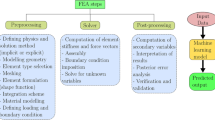Abstract
The use of constitutive equations calibrated from data has been implemented into standard numerical solvers for successfully addressing a variety problems encountered in simulation-based engineering sciences (SBES). However, the complexity remains constantly increasing due to the need of increasingly detailed models as well as the use of engineered materials. Data-Driven simulation constitutes a potential change of paradigm in SBES. Standard simulation in computational mechanics is based on the use of two very different types of equations. The first one, of axiomatic character, is related to balance laws (momentum, mass, energy,\(\ldots \)), whereas the second one consists of models that scientists have extracted from collected, either natural or synthetic, data. Data-driven (or data-intensive) simulation consists of directly linking experimental data to computers in order to perform numerical simulations. These simulations will employ laws, universally recognized as epistemic, while minimizing the need of explicit, often phenomenological, models. The main drawback of such an approach is the large amount of required data, some of them inaccessible from the nowadays testing facilities. Such difficulty can be circumvented in many cases, and in any case alleviated, by considering complex tests, collecting as many data as possible and then using a data-driven inverse approach in order to generate the whole constitutive manifold from few complex experimental tests, as discussed in the present work.














Similar content being viewed by others
References
Brunton SL, Proctor JL, Kutz JN (2016) Discovering governing equations from data by sparse identification of nonlinear dynamical systems. Proc Nat Acad Sci 113(15):3932–3937
Chinesta F, Leygue A, Bordeu F, Aguado JV, Cueto E, Gonzalez D, Alfaro I, Ammar A, Huerta A (2013) Parametric PGD based computational vademecum for efficient design, optimization and control. Arch Comput Methods Eng 20(1):31–59
Chinesta F, Keunings R, Leygue A (2014) The proper generalized decomposition for advanced numerical simulations: a primer. Springer, New York
Crespo J, Latorre M, Montans F (2017) WYPIWYG hyperelasticity for isotropic, compressible materials. Comput Mech 59(1):73–92
Gonzalez D, Ammar A, Chinesta F, Cueto E (2010) Recent advances in the use of separated representations. Int J Numer Methods Eng 81(5):637–659
Gonzalez D, Cueto E, Chinesta F (2015) Computational patient avatars for surgery planning. Ann Biomed Eng 44(1):35–45
Gonzalez D, Aguado JV, Cueto E, Abisset-Chavanne E, Chinesta F (2016) kPCA-based parametric solutions within the PGD framework. Arch Comput Methods Eng. doi:10.1007/s11831-016-9173-4
Ibanez R, Abisset-Chavanne E, Aguado JV, Gonzalez D, Cueto E, Chinesta F (2016) A manifold learning approach to data-driven computational elasticity and inelasticity. Arch Comput Methods Eng. doi:10.1007/s11831-016-9197-9
Kirchdoerfer T, Ortiz M (2016) Data-driven computational mechanics. Comput Methods Appl Mech Eng 304:81–101
Lee JA, Verleysen M (2007) Nonlinear dimensionality reduction. Springer, Berlin
Liu Z, Bessa MA, Liu WK (2016) Self-consistent clustering analysis: an efficient multi-scale scheme for inelastic heterogeneous materials. Comput Methods Appl Mech Eng 306:319–341
Lopez E, Gonzalez D, Aguado JV, Abisset-Chavanne E, Cueto E, Binetruy C, Chinesta F (2016) A manifold learning approach for integrated computational materials engineering. Arch Comput Methods Eng. doi:10.1007/s11831-016-9172-5
Michopoulos J, Farhat C, Houstis E (2004) Dynamic-data-driven real-time computational mechanics environment. In: Bubak M, van Albada GD, Sloot PMA, Dongarra J (eds) Computational scienceICCS 2004: 4th international conference, Krakow, Poland, June 6–9, 2004, proceedings, Part III. Springer, Berlin, pp 693–700
Olson GB (2000) Designing a new material world. Science 288(5468):993–998
Peherstorfer B, Willcox K (2015) Dynamic data-driven reduced order models. Comput Methods Appl Mech Eng 291:21–41
Peherstorfer B, Willcox K (2016) Data-driven operator inference for nonintrusive projection-based model reduction. Comput Methods Appl Mech Eng 306:196–215
Polito M, Perona P (2001) Grouping and dimensionality reduction by locally linear embedding. In: Advances in neural information processing systems, vol 14. MIT Press, pp. 1255–1262
Raghupathi W, Raghupathi V (2014) Big data analytics in healthcare: promise and potential. Health Inf Sci Syst 2(1):1–10
Roweis ST, Saul LK (2000) Nonlinear dimensionality reduction by locally linear embedding. Science 290(5500):2323–2326
Tenenbaum JB, de Silva V, Langford JC (2000) A global framework for nonlinear dimensionality reduction. Science 290:2319–2323
Wang Q (2012) Kernel principal component analysis and its applications in face recognition and active shape models. CoRR. arXiv:1207.3538
Acknowledgements
This work has been supported by the ESI GROUP Chair at Ecole Centrale of Nantes as well as by the Spanish Ministry of Economy and Competitiveness, through grants number CICYT DPI2014-51844-C2-1-R and DPI2015-72365-EXP and by the Regional Government of Aragon and the European Social Fund, research group T88. This support is gratefully acknowledged.
Author information
Authors and Affiliations
Corresponding author
Rights and permissions
About this article
Cite this article
Ibañez, R., Borzacchiello, D., Aguado, J.V. et al. Data-driven non-linear elasticity: constitutive manifold construction and problem discretization. Comput Mech 60, 813–826 (2017). https://doi.org/10.1007/s00466-017-1440-1
Received:
Accepted:
Published:
Issue Date:
DOI: https://doi.org/10.1007/s00466-017-1440-1




